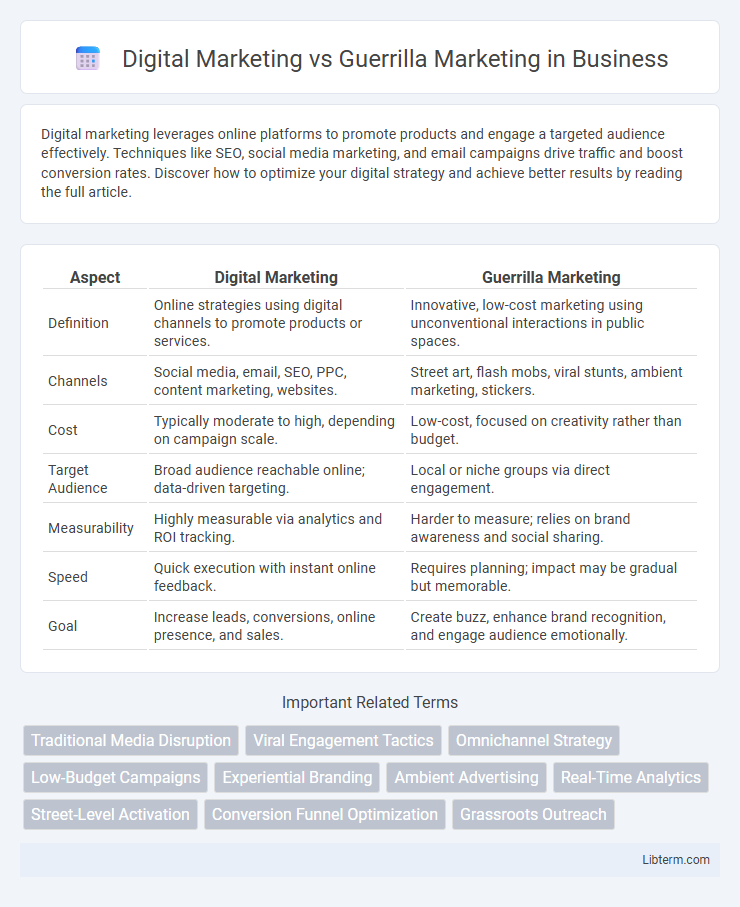Digital marketing leverages online platforms to promote products and engage a targeted audience effectively. Techniques like SEO, social media marketing, and email campaigns drive traffic and boost conversion rates. Discover how to optimize your digital strategy and achieve better results by reading the full article.
Table of Comparison
| Aspect | Digital Marketing | Guerrilla Marketing |
|---|---|---|
| Definition | Online strategies using digital channels to promote products or services. | Innovative, low-cost marketing using unconventional interactions in public spaces. |
| Channels | Social media, email, SEO, PPC, content marketing, websites. | Street art, flash mobs, viral stunts, ambient marketing, stickers. |
| Cost | Typically moderate to high, depending on campaign scale. | Low-cost, focused on creativity rather than budget. |
| Target Audience | Broad audience reachable online; data-driven targeting. | Local or niche groups via direct engagement. |
| Measurability | Highly measurable via analytics and ROI tracking. | Harder to measure; relies on brand awareness and social sharing. |
| Speed | Quick execution with instant online feedback. | Requires planning; impact may be gradual but memorable. |
| Goal | Increase leads, conversions, online presence, and sales. | Create buzz, enhance brand recognition, and engage audience emotionally. |
Introduction to Digital Marketing and Guerrilla Marketing
Digital marketing utilizes online platforms and technologies such as SEO, social media, email campaigns, and pay-per-click ads to reach a broad audience and drive measurable engagement. Guerrilla marketing employs unconventional, low-cost tactics like street art, flash mobs, and viral stunts to create memorable brand experiences and generate buzz. Both strategies aim to increase brand awareness but differ in approach, scale, and interaction with target audiences.
Defining Digital Marketing: Key Features and Channels
Digital marketing encompasses all online marketing efforts using digital channels such as search engines, social media, email, and websites to reach and engage target audiences. Key features include measurable results through analytics, highly targeted campaigns, and real-time interaction with customers. Channels like SEO, PPC, content marketing, and social media advertising enable businesses to optimize reach and conversion rates effectively.
What is Guerrilla Marketing? Core Concepts and Examples
Guerrilla marketing is an unconventional advertising strategy that relies on creativity, surprise, and low-cost tactics to engage audiences in unexpected ways, often in public spaces. Core concepts include ambush marketing, experiential campaigns, and viral content designed to generate buzz and maximize impact with minimal budgets. Iconic examples include the Nike "Jogging Boxers" campaign and the UNICEF "Dirty Water Vending Machine," both leveraging surprise and interactivity to create memorable brand experiences.
Target Audience: Who Benefits from Each Approach?
Digital marketing benefits businesses aiming to reach broad or specific online audiences through data-driven targeting on platforms like social media, search engines, and email campaigns. Guerrilla marketing is ideal for brands seeking to create memorable, low-cost, and high-impact interactions within local or niche communities. Companies with larger budgets and scalability goals prefer digital marketing, while startups and small businesses leverage guerrilla marketing for creativity and direct engagement.
Cost Analysis: Budgeting for Digital vs Guerrilla Campaigns
Digital marketing campaigns typically require a higher initial budget for tools, software, and paid ads, but offer precise targeting and measurable ROI through platforms like Google Ads and Facebook Ads Manager. Guerrilla marketing leverages creativity and unconventional tactics, often resulting in lower direct costs but higher unpredictability in reach and impact, utilizing street art, flash mobs, or viral stunts to capture attention. Cost analysis should weigh digital marketing's scalability and analytics against guerrilla marketing's budget-friendly, high-engagement potential with potentially limited audience tracking.
Measuring Success: Metrics and Analytics
Digital marketing leverages advanced metrics such as click-through rates (CTR), conversion rates, cost per acquisition (CPA), and website traffic analytics to measure campaign success with precise data. Guerrilla marketing success is often gauged through engagement metrics like social media shares, viral reach, and direct audience interaction, which provide qualitative insights into brand impact. Combining digital analytics tools with real-world feedback enhances the overall assessment of marketing effectiveness across both strategies.
Creativity and Innovation in Both Marketing Strategies
Digital marketing leverages data-driven creativity and innovative technologies such as AI, SEO, and social media platforms to deliver personalized and scalable campaigns. Guerrilla marketing thrives on unconventional, highly imaginative tactics that capture attention through surprise elements and low-cost, impactful executions in physical or digital environments. Both strategies demand creative brainstorming and innovation, but digital marketing prioritizes technological integration while guerrilla marketing emphasizes bold, memorable physical engagement.
Scalability and Reach: Local vs Global Impact
Digital marketing leverages online platforms and data analytics to achieve scalable, global reach, enabling businesses to target diverse audiences across multiple regions simultaneously. Guerrilla marketing focuses on highly creative, low-cost tactics with a strong local impact, relying on physical presence and word-of-mouth to engage specific communities deeply. The scalability of digital marketing contrasts with the localized, experiential nature of guerrilla campaigns, making each suitable for different strategic goals.
Case Studies: Successful Digital and Guerrilla Campaigns
Case studies reveal Digital Marketing campaigns such as Nike's "Dream Crazy," leveraging social media platforms to generate viral engagement and boost brand loyalty. Guerrilla Marketing successes include the ALS Ice Bucket Challenge, which utilized unconventional tactics and public participation to raise awareness and funds exponentially. Both strategies harness creativity and audience interaction but differ in scale, cost, and media channels used.
Choosing the Right Strategy for Your Business
Choosing the right marketing strategy depends on your business goals, target audience, and budget constraints. Digital marketing leverages online platforms like social media, SEO, and email campaigns to reach a broad, measurable audience with scalable results. Guerrilla marketing employs unconventional, creative tactics to generate high-impact, localized engagement, ideal for businesses seeking unique brand awareness on a limited budget.
Digital Marketing Infographic

 libterm.com
libterm.com